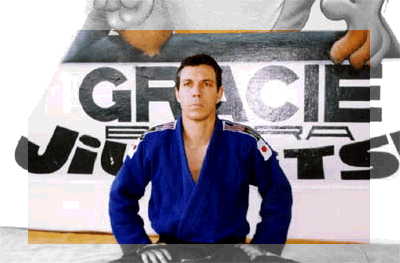|

Jiu-Jitsu,
translated as 'the gentle art,' is the oldest form of martial
art. It has also been defined with terms like yielding,
softness, subtleness, and pliability. Its origins date back to
India more than 2,000 years before Christ. From there it spread
throughout Asia and eventually settled in Japan.
In
1914, Japanese Jiu-Jitsu champion Esai Maeda arrived in Brazil
to help establish a Japanese immigration colony. Once in Brazil
Gastao Gracie, a Brazilian scholar and politician of Scottish
decent aided him. To show his gratitude, the oriental master
taught the basic secrets of that ancient fighting style to
Gastao's son, Carlos Gracie. Carlos taught Maeda's techniques to
his brothers: Oswaldo, Gastao, Jorge and Helio and in 1925 they
opened the first Jiu-Jitsu Academy in Botafogo, a district of
Rio de Janeiro, Brazil. This is where the brothers prompted by
Carlos, essentially designed and laid the foundation for
'Brazilian' Jiu-Jitsu.
Carlos Gracie, who was interested in
stree-tfighting and was also a boxer, quickly modified the
classical techniques he learned from Count Koma to meet the
demands of real, "no rules" fighting in the streets of
Brazil. The young Carlos Gracie then tested and refined his system through
constant matches, open to all comers, constantly working to make
it more effective. At one point, he even advertised in
newspapers and on street corners for new opponents upon whom to
practice and further refine his art. He fought anyone and
everyone who was willing, regardless of size, weight or fighting
style. Even though he was a mere 135 pounds, his style was so
effective that Carlos
Gracie was never defeated and became a legend in
Brazil.
This
tradition of open challenge is a part of the heritage of the
Gracie style of Jiu-Jitsu. Carlos
Gracie taught his style of Jiu-Jitsu. to his
four younger brothers (Oswaldo,
Gastão,
Jorge,
and finally Helio)
and to his older sons (including Carlson and Carley), and they
in turn taught their brothers, sons, nephews and cousins. After
Carlos retired from the ring, he managed the fight careers of
his brothers and sons, continuing to challenge fighters of all
styles throughout the world. This tradition of open challenge
has been continued by his sons, grandsons, brothers, nephews,
and students, who have consistently demonstrated the superiority
of the Gracie style in real fights and minimum-rule matches in
rings throughout the world.
Carlos
Gracie had 21 children and his youngest brother Helio had 7
sons, creating a virtual dynasty of Gracie fighters and
instructors who dominate the world of "no rules" fight
contests today. In these events, Gracie representatives have
consistently demonstrated, in open competition against title
holders from other martial arts styles, that the Gracie style of
Jiu-Jitsu. is the most effective fighting art in the world
today. No small wonder that the Gracie style of Jiu-Jitsu is the
"hottest" item in martial arts today.
Carlos Gracie, Jr., one of Carlos' sons, opened the Barra
Gracie in Rio de Janeiro and has, since its inauguration,
trained several champions in Brazil. The Ultimate Martial Arts
is proud to have Paulo Castro
teaching Carlos Gracie, Jr.'s techniques at our school in Boca
Raton, FL.

Carlos Gracie, Jr.
|









